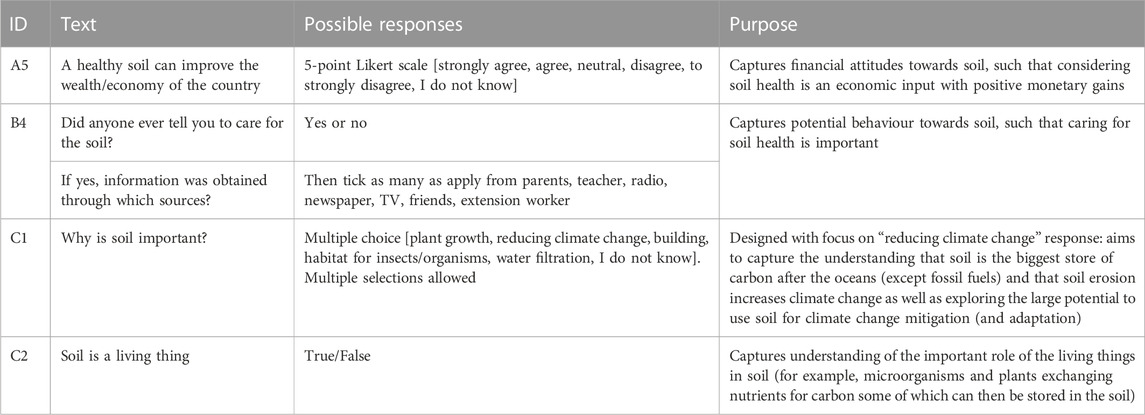- 1Department of Engineering, Durham University, Durham, United Kingdom
- 2Water Institute at Stellenbosch University, Stellenbosch, South Africa
- 3School of Applied Social Sciences, Stirling University, Stirling, Scotland, United Kingdom
- 4Department of Biosciences, Durham University, Durham, United Kingdom
- 5Department of Soil Science at Stellenbosch, Durham University, Durham, United Kingdom
- 6OASES (Outdoor and Sustainability Education Specialists) Durham, Durham County Council, Durham, United Kingdom
Soil health underpins ecosystem services like food security and therefore underpins human health. Poor soil health is a global problem which is hindering attempts to deliver the UN’s Sustainable Development Goals. We focus on goals 3 (human health), 13 (climate change) which are intimately linked to goal 15 (soil health). Soil health is arguably most fragile in regions such as sub-Saharan Africa (SSA) where aged soils are characterised by poor nutrient and water holding capacity, and are largely deficient in micronutrients such as Zinc. Poor soil health coupled with the largely cereal-based diets can mean that micronutrient malnutrition is high in the region. In sub-Saharan Africa, where much of the population is too poor to purchase mineral supplements, poor soil health (SDG15) can therefore negatively impact on human health (SDG3). We surveyed 3661 school children aged 13–15 in three African countries, Ghana, South Africa and Zimbabwe, for their ‘Attitudes, Behaviours and Competencies’ of soil, which we termed ‘ABC’. The ‘ABC’ survey results showed significant soil illiteracy. The survey showed that although students were generally equipped with a good attitude to (overall 52% positive) and behaviour towards soil (overall 60% engagement), they had little competency as to how to improve soil health (overall 23% knowledge). For example, less than 35% of respondents across all countries know that soil is living. Less than 13% of students are aware of the important role of soil in climate change mitigation. We believe that these two knowledge gaps must be addressed for Generation Z to understand the important linkages between climate change, soil and human health. We propose a hands-on ‘ethics of care’ approach to engage society with soil, piggybacking on existing climate change educational resources by building terrariums with living soil can empower children to learn about soil, plant, human and planetary health. The future of food security depends on Generation Z having soil literacy. Our survey clearly shows that students who think farming is a good way to make money have significantly higher levels of overall soil literacy. We propose that the future of human health depends on soil literacy.
Introduction
Soil health is a multi-faceted and complex term, just like human health is also a multi-faceted and complex term. We care about human health and we need to care about soil health as the two are intrinsically linked for example through food security and micronutrient provision (e.g., Platel and Srinivasan, 2016). The ‘One Health Initiative’ links soil health to plant, animal, human and planetary health (Ohno and Hettiarachchi, 2018). Poor soil health also hinders our attempts to meet the UN’s Sustainable Development Goals (SDGs) (Keestra et al., 2016). We focus on the linkages between the SDGs for human health (SDG3), climate change (SDG13) and soil health (SDG15) as shown in Figure 1.
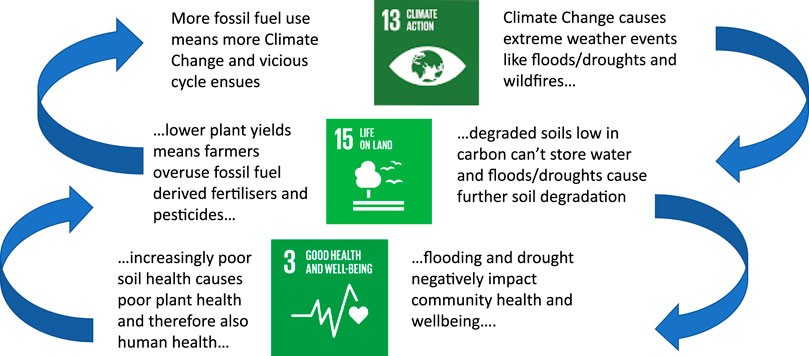
FIGURE 1. Simplified vicious cycle of soil degradation and climate change linking SDG3 (human health) with SDG15 (soil and plant health) and SDG13 (climate change). Both the extreme weather events associated with climate change and soil degradation caused by these negatively impact human health.
Land degradation is responsible for a significant proportion of all global greenhouse gas emissions (Lal, 2016) through soil organic matter loss. This leads to poorer soil health which increases the vulnerability of soils to erosion, floods and drought. Because this degraded soil often lacks the ability to hold onto vital nutrients and water, this negatively impacts on agricultural production, resulting in smaller yields per capita. This negative impact is most acute in regions like sub-Saharan Africa (SSA) where the majority of poor farmers can only afford to use <10 kg ha-1 year-1 of macronutrient fertilisers to boost crop yields (eg., Sanchez, 2002; Chianu and Mairura, 2012). Lack of micronutrients such as zinc (Zn) leads to poor quality crops and directly impacts on human health through consumption of less nutritious foods (Ceruti et al., 2003). Rebuilding soil health using inorganic minerals at the same time as organic matter can provide a pathway to return micronutrients to the soil thereby improving human health (Johnson et al., 2020). However, there is a general lack of literacy skills to be able to rebuild soil health, even among farmers and agricultural practitioners. Indeed the lack of access to information and knowledge itself are some of the factors identified by Gwandu et al. (2014) which constrain adoption of agricultural technologies to improve soil health in SSA. This soil illiteracy has caused a vicious cycle between soil degradation and climate change with detrimental results for human health (see Figure 1).
Figure 1 is a gross simplification of a complex set of interactions. However, society’s soil illiteracy has driven and continues to drive soil degradation, and it is the paralysing complexity of knowledge stimying communication that is the driving factor of this illiteracy (De bruyn and Abbey, 2003). The lack of soil literacy is not just among children and farmers but policymakers too. Examples of this include climate change educational resources from both the UN and NASA neither of which mention soil (https://together-for-our-planet.ukcop26.org/schools-pack-resources/ and https://climatekids.nasa.gov/mini-garden/). And yet soil is the biggest store of organic carbon on Earth after fossil fuels (Trumbore, 1997). Although soil scientists have known for generations that soil is living, society does not treat it as living. This is not a criticism but an observation which presents a timely opportunity for society to adopt a more holistic approach to addressing the UN’s Sustainable Development Goals 3, 13, and 15.
Healthy soil is often defined as the ability of soil to deliver essential ecosystem services, a subset of which includes food security, climate change adaptation and mitigation (Johnson, 2022). Like a healthy human has a healthy gut microbiota (referred to as eubiosis), healthy soil has a healthy microbiota (or microbiome). Johnson. (2022) define a healthy soil microbiome as one that “maintains a high diversity of functions across a range of organisms having as broad a range of traits as possible”. Understanding the links between soil microbiota and gut microbiota (and therefore overall human health) is in its infancy, but it is clear that there are strong links (Blum et al., 2019; Brevik et al., 2020). Excessive use of chemical fertilisers (artificially high nutrients) and pesticides/herbicides to increase crop yields alters the soil microbiome, often resulting in soil degradation and a less healthy soil microbiome. This mirrors the dysbiosis effects of a high nutrient (sugar or fat) diet (de Oliveira Neves et al., 2020; Tremaroli, V., & Bäckhed, 2012) and antibiotics (Francino, 2016) on human microbiota. The same ecological dysbiosis phenomenon is common in fresh and saltwater ecosystems, with eutrophication due to high nutrients (Liang et al., 2021), and the vast ecological impacts of antibiotics (Zhu et al., 2022) on aquatic microbiota and on soil microbiota (Cycon et al., 2019).
Due to soil degradation, the cost of maintaining sustainable yields increases over time, because soil degradation affects many soil ecosystem services (Baveye et al., 2016) including water and nutrient holding capacities. In addition, chemical fertilizers and pesticides, which are derived from fossil-fuels, contribute directly to climate change, while their overuse in soil contributes indirectly to climate change through nitrous oxide emissions from the soil, as well as human ill-health through exposure to pesticide/herbicide residues. Further to that, climate change-induced extreme weather events such as droughts, wildfires and floods further exacerbate soil degradation and food insecurity, as well as having negative consequences for human mental and physical health. Food insecurity has direct negative impacts on human health through loss of resources and livelihoods. Human health is also tied to diet and in sub-Saharan Africa, diet is mainly plant-based (O’Keefe, 2019) and locally derived. Where soil degradation has resulted in loss of micronutrients such as zinc (Platel and Srinivasan, 2016), malnutrition (or “hidden hunger”) is often the result.
In this paper, we present some of the main findings from a soil literacy survey (Johnson et al., 2020) of a population of school children in three African countries: Ghana, South Africa and Zimbabwe. We use these findings to propose an ‘ethics of care’ educational model (meaning we must care for the soil because it is living) to address the institutionalised gap in soil literacy. By piggy-backing the main soil health messages onto existing climate change educational resources, we think it possible to improve soil literacy within Generation Z. This might enable them to take part in the “rebuild soils” effort (Johnson, 2022), and thus improve human health in regions such as sub-Saharan Africa, as well as contributing to climate change adaptation and mitigation at a population level.
Methods
We used a simple questionnaire survey (see Supplementary Information) in the three sub-Saharan countries, South Africa, Zimbabwe and Ghana. We targeted school children from Generation Z, aged between 13 and 15, to elicit feedback on different aspects of soil literacy. We defined soil literacy as a combination of attitudes, behaviours and competencies required to make sound decisions that prevent soil degradation and promote soil health and ultimately contribute to the maintenance and enhancement of the natural environment. Although there is no consensus, we define soil health as the ability of soil to deliver essential ecosystem services, a subset of which includes food security and climate change adaptation and mitigation (Johnson, 2022). The soil literacy questionnaire was developed in close collaboration with a wide range of experts in soil science, survey design and statistical modelling. This questionnaire also captured a range of respondents’ individual- and household-level demographic and background characteristics. The survey encapsulated 3,661 respondent-observations of school children aged 13–15 were obtained roughly equally split between the three countries (Johnson et al., 2020). One expert from each country visited a similar range of schools within each country (including private and state-run schools so that we accessed a broad cross-section of pupils from different socio-economic statuses). The expert explained briefly to each class the purpose of the survey and stayed with them while they completed it.
Our survey was conducted in these three countries for two reasons. Firstly because the authors strong connections with educational institutes from these countries and secondly we wanted two countries in sub-Saharan Africa which were close geographically (for both soil and cultural reasons) but different in terms of human development index (HDI). Zimbabwe has a Human Development Index of 0.57 and South Africa of 0.71 (2019 data) and one country Ghana which was geographically further away with more variability in soil health issues and cultural factors but a similar HDI to Zimbabwe (Ghana has an HDI of 0.61). Soil health is difficult to define. Our survey was based largely on an agricultural perspective on soil health. We had a team of three soil scientists (two from Zimbabwe, one from South Africa) and one environmental engineer one plant scientist and one social scientist with extensive experience of designing surveys (all United Kingdom). The questionnaire was designed to elicit the attitudes, behaviours and competencies of respondents regarding various cultural, societal and financial dimensions of soil and its properties; engagement with soil and fertilizers in the respondents” everyday lives; as well as respondents’ knowledge about soil, fertilizer use and other determinants of soil health, as well as soils’ relationships to changes in the natural environment, such as climate change, carbon sequestration and wind or water erosion. The survey was then reviewed by one other soil expert in each of the three countries and it was this person who conducted the survey in each country in every school in case there were any queries about the questions. The survey design relied on a pilot study approach, which gathered non-probability-based convenience samples to examine the proof of concept. Across these three countries, 3,661 respondent observations were collected (1,797 in Ghana, 956 in South Africa and 908 in Zimbabwe), covering a total of 39 schools of varying institution types (day school or boarding; agricultural-focused schools vs. others; private or public; and mission or non-mission). Specifically, paper questionnaires were issued to each trained fieldwork team, who then organised trips to the respective schools to administer the survey between April and July 2019. The responses were then collated by Durham University for analysis. The survey also captures a range of respondents’ individual- and household-level demographic and background characteristics, as well as broader questions relating to agriculture and soil-related professions so that it was clear whether these demographics had an impact on answers. All schools taught in English and information was collected on the other languages children spoke.
More details on the rationale behind each individual question is covered in Johnson et al., 2020; Table 1 shows some of the Attitude, Behaviour and Competency (A, B, C) questions and our rating of how difficult the questions were. However this paper focusses on the most statistically significant results which additionally were significant across all three countries and independent of demographic data. These questions includes one Attitude question, A5 “A healthy soil can improve the wealth/economy of a country” (yes or no answer), one Behaviour question, B4 “Did anyone tell you to care for the soil” and two Competency questions, C1 (tick all the reasons) “Why is soil important: plant growth, reducing climate change, building habitat for insects and other organisms, building, water filtration, I don’t know” and C2 (yes or no) “Soil is living”. Table 2 shows the rationale behind these four questions.
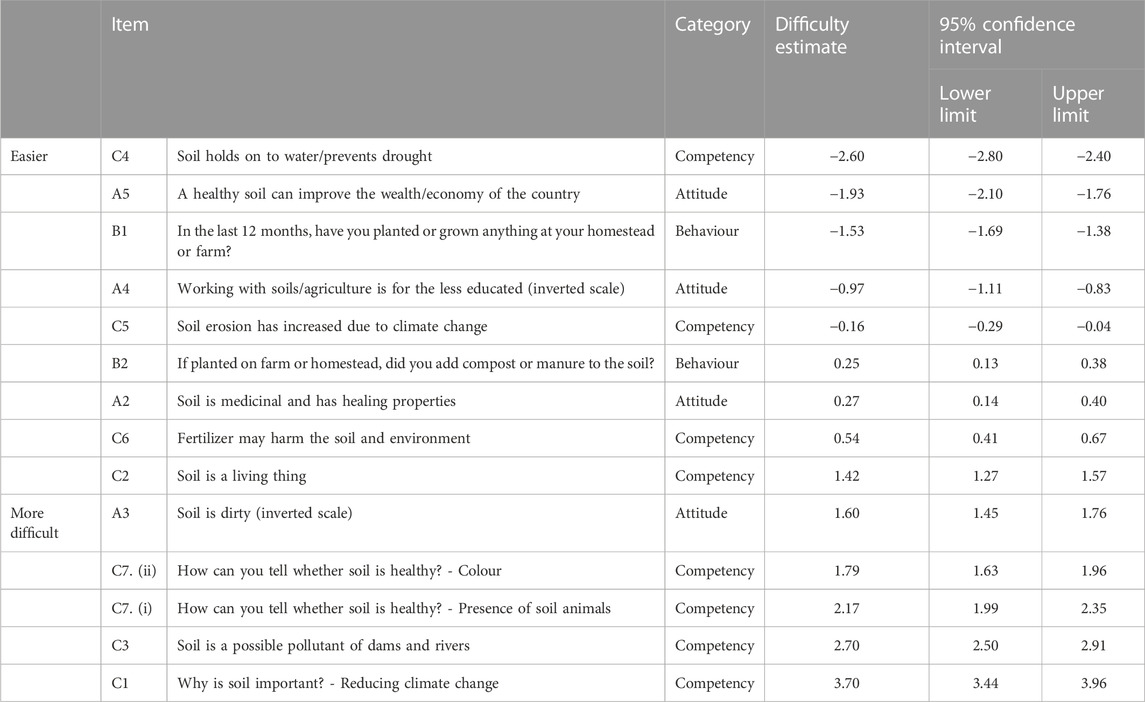
TABLE 1. Abridged versions of the questions asked in the survey, in order of their ‘difficulty ratings’. The methodological approach known as Item Response Theory (IRT) was used to assess question difficulty (Table taken from, and more details in, Johnson et al., 2020).
Attitudes towards soil are captured by a general attitude question together with others that elicit the specific cultural, societal and financial attitudinal dimensions of soil literacy (amounting to a total of five attitude questions in total). Behaviour towards soil is measured by establishing whether respondents planted anything at their homestead in the last 12 months, and if so, whether they used compost or manure (amounting to two behaviour questions in total). Competencies and specific knowledge around soil were assessed via a set of seven questions, which include understanding the relation between soil erosion and climate change, and in particular, knowing about the importance of soil in reducing climate change as well as whether or not soil was living.
Briefly, (more details available in Johnson et al., 2020 and in original survey attached as SI) we used the results to create an overall semi-quantitative measure of soil literacy (total ABC score). We also split the results into the separate scales for the attitudes, behavioural and competencies dimensions. T-tests were employed to test for significant per-question differences between countries (and in the report this was investigated further by gender). Briefly, difficulty levels for questions were estimated jointly using Item Response Theory (IRT), a modelling approach which assumes that individuals’ soil literacy is fundamentally latent (modelled by z_j for respondent j) and that in order to answer a given question correctly, the respondents’ soil literacy needs to be higher than the question difficulty level (modelled by b_i, so that z_j > b_i for correct answers to question i). The confidence intervals reported in Table 2 exclude zero, so all difficulty estimates are statistically significant at the 5% level.
Results and discussion
Table 3 shows the main findings expressed as ‘percentages’ from 0.01 to 0.99 for selected questions. The countries are represented by the numbers 1) Ghana, 2) South Africa and 3) Zimbabwe and differences between countries represented by (1)–(2) for example, to represent statistically significant differences between Ghana and South Africa. The statistical significance between the difference in two countries’ response is shown as follows: p < 0.1 *, p < 0.05 **, p < 0.01 ***
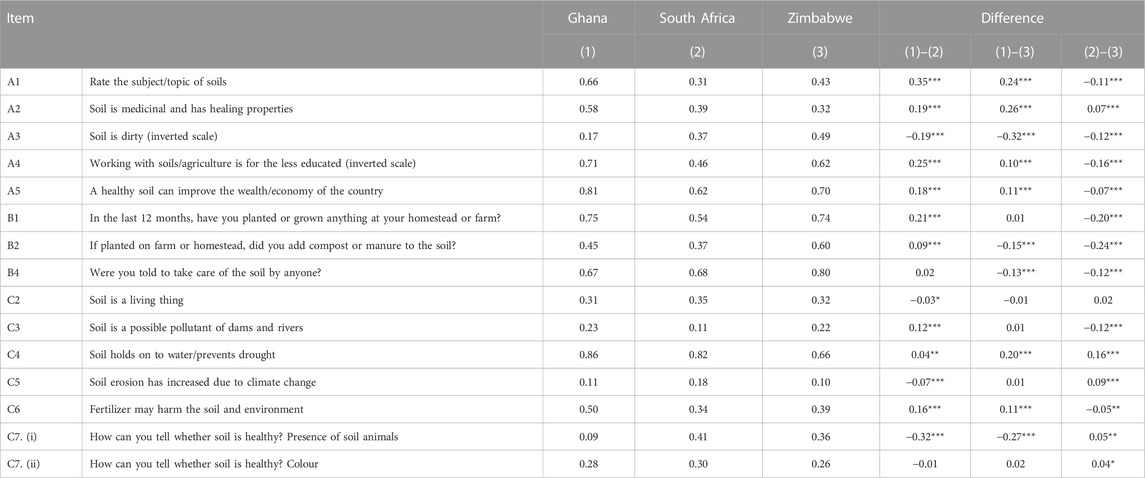
TABLE 3. Abridged results from selected questions from the ABC of Soil survey (from Johnson et al., 2020).
It is clear that Attitudes (“A” questions) towards soil are mixed. The majority (between 62% and 81%) think that healthy soils can improve the wealth or economy of a country. Unsurprisingly, across countries, enjoyment of the topic of soils is highly variable, with 31%–66% of respondents stating they enjoy the subject. The Behaviour responses (“B” questions) suggest that the majority of respondents practically engage with soil and most engage in prudent soil practices. Between half and three-quarters of respondents planted at their homestead and of those approximately two-thirds to four-fifths used compost or manure. Figure 2 shows the specific responses to question B4, reporting the proportions of individuals indicating that they were told they ought to take care of soil. The proportion answering “Yes” equals two-thirds in Ghana (66.6%) and South Africa (68.1%), and four-fifth (80%) in Zimbabwe. This suggests that harnessing and populating an ‘ethics of care’ approach to improving soil literacy may be effective, as students already know they should take care of soil, but they don’t have the knowledge of how to do so (Gwandu et al., 2014), which is a paralysing educational approach.
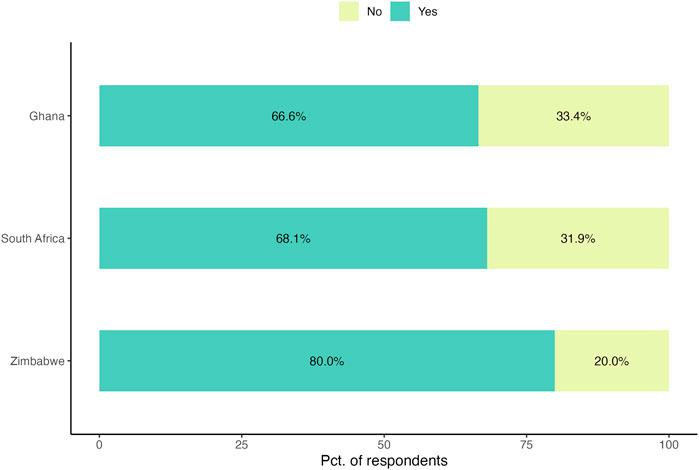
FIGURE 2. ‘Did anyone tell you that you should take care of the soil?’ question B4 from the ABC of Soil survey—yes or no. Taken from Johnson et al (2020).
The questionnaire also captured which sources respondents received information about caring for the soil (see Figure 3 below).
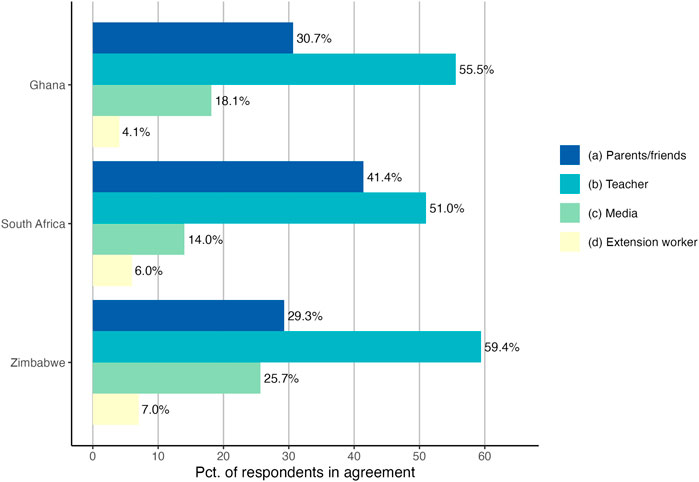
FIGURE 3. Information sources of soil care from the ‘ABC of Soil’ survey. Taken from Johnson et al (2020).
The answer distributions appear stable across countries: teachers are the information source cited most frequently by respondents, with proportions greater than one-half in each country (55.9% in Ghana, 51.0% in South Africa and 59.4% in Zimbabwe). The second most frequently cited source is parents, chosen by roughly one-third of respondents (30.7%, 41.4%, and 29.3%. The third source most cited is media (18.1%, 14.0%, and 25.7%), while with negligible proportions fall towards extension workers (4.1%, 6.0%, and 7.0%). Extension workers are government-employed soil scientists or equivalent who are knowledgeable about soil, and tasked with providing technical assistance and knowledge transfer to the agricultural sector. These figures suggest the natural place for interventions to be most effective is in the educational curriculum, in order to raise soil literacy levels.
The survey shows, as one might expect, that attitudes and behaviours vary by country, by as much as 30% in more than one indicator analysed in this survey, and policymakers should shy away from a one-size-fits-all approach. More work is needed to obtain quantitative and qualitative evidence for each country’s particular attitudes and behaviours towards soil. Tailoring policy to local and culture-specific challenges will maximise the likelihood of success.
The most interesting findings were in the Competencies (“C” questions which test a student’s knowledge of soil). The results show that many respondents do not have basic soil competencies or knowledge. Figure 4 depicts the average ABC scores (solid bars) in relation to the maximum achievable soil literacy (transparent bars). There is considerable scope for improvement in terms of overall levels of soil literacy, across all dimensions of attitudes, behaviours and competencies. However, on average, respondents exhibit half of the desirable soil-related attitudes and behaviours, but only around one-third of soil competencies are displayed.
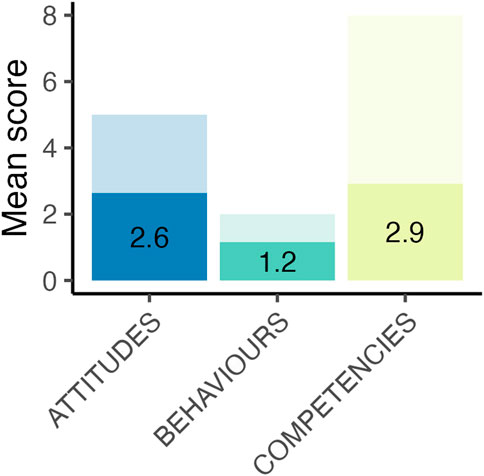
FIGURE 4. Overall soil literacy (solid bars indicate average scores and transparent bars maximum scores of 5 in Attitude, 2 in Behaviours and 8 in Competencies) with percentages given. These results particularly speak to a need of increased educational efforts with respect to increasing knowledge (competencies) around soil which is averaged as 23% correct answers (from Johnson et al, 2020).
There is a generally positive attitude towards soil (52% positive Attitude) and overall positive Behaviour (60%) towards soil however coupled with the lack of knowledge (23% Competencies) this constitutes a paralysing educational design, promoting care without competency. With the advent of industrialisation, children are also generationally separated from the soil. This is supported in these survey results, with South African students demonstrating 20% less engagement with soil than Ghana and Zimbabwe (Table 2). According to the Industrialisation Intensity Index (II Index) developed by the World Bank, South Africa has a higher ‘II Index’ than the world median, whereas both Ghana and Zimbabwe are significantly lower (TCData360, https://tcdata360.worldbank.org/indicators/mva.ind.int?country = ZAF&indicator = 3793&countries = GHA,ZWE&viz = line_chartandyears = 1990,2018). Thus, as systemised farm-to-table approaches are applied, separating children from the soil, students become less aware of their place in the societal and planetary system, and basically, more disconnected from how they should interact with the soil.
By placing the onus of care on the students (“Attitudes” and “Behaviours”), without equipping them with rigorous scientific tools (“Competency”) to execute care, this feeds into a general burden of hopelessness in the curriculum. There is growing evidence of climate distress (measured as anxiety, depression, grief and apathy) amongst adults and students alike (Searle and Gow, 2010; Verlie et al., 2021). Interestingly, Clayton and Karazsia (2020) showed that climate change anxiety is correlated to emotional changes amongst young adults, but not behavioural changes. These studies, as well as this survey, suggest that at an educational level, “Competency” seems to be the key broken link, and physical interventions giving students early hands-on experience with soil, based on a holistic understanding of the full ecosystem, is an ideal intervention.
It is clear that there is a common and significant lack of knowledge around soil particularly in two key areas. The first key competency knowledge gap exposed by the ‘ABC of Soil’ survey is that although the majority of respondents (51%) are aware of the effect of climate change on soil erosion; only a small proportion (13%) of respondents know of the effects that soil erosion has on climate change. Taken together, these results imply a key blind spot in the understanding of environmental interlinkages between soil and extreme weather events like flooding and drought (see Figure 1) that contribute to the greatest global challenge of this century: combatting climate change. This, of course, is not entirely surprising as the fact that climate change and soil degradation are intimately connected both to each other (and to human health, see Figure 1) is not known to many, if not most, adults either. However, this lack of soil literacy is alarming, as soil health is the foundation of not just human health but also key to climate change mitigation and adaptation.
The second key competency knowledge gap from the ‘ABC of Soil’ survey is that less than 35% of children considered soil to be living (see Figure 5). The distinction between alive and inanimate objects has direct implications for the care with which they are treated. As a rule, animals are treated with more considerations than are rocks, with plants and trees falling somewhere in between. Soil can and should be regarded as living matter not only because the soil microbiota is living, but because of the importance of a healthy soil to human health. Without living microorganisms, soil cannot fulfil its essential functions of plant growth, retaining water or storing carbon. In addition, the approach to managing an inert system is vastly different to the approach to managing a living system, both from a relational perspective, and a complexity perspective. Abiotic systems are often less dynamic, and systems are easily measurable and therefore comparable. Thus, these can generally be approached from the perspective of fundamental, universal theories, which facilitates simple management. In contrast, a living biotic system typically must be approached from a local, case-specific context. Theories are less universally applicable in the context of biotic systems than abiotic systems. For instance, whether in Europe or Africa, the addition of zinc to a particular abiotic chemical system will have the same effect. However, human gut microbiota will likely have a vastly different response to the addition of a particular micronutrient in Europe than in Africa, because diet and nativity drive the establishment of the gut microbiota (Peters et al., 2020). Similarly with soil, the addition of a particular micronutrient to a soil system will likely have a vastly different response in Europe, or even within a specific country than in Africa because of different geology and plant-life being controlling factors. A similar shift from universal theories to context-driven understanding will be necessary for soil literacy and management, with respective shifts in underpinning educational resources and understanding required.
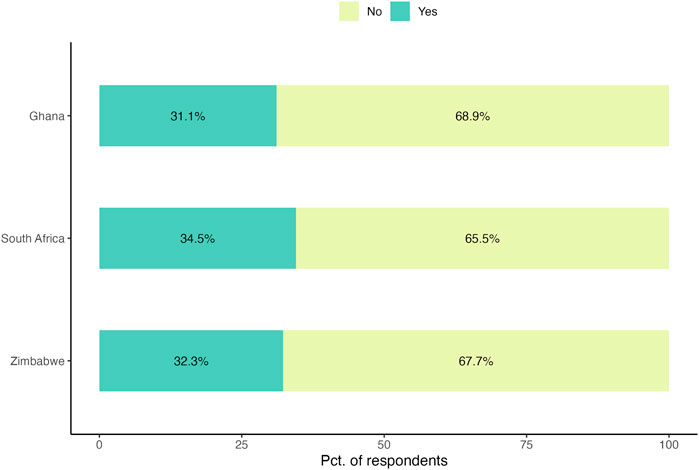
FIGURE 5. The survey invited respondents to choose between “Yes” and “No” in regard to the statement C2 “Soil is a living thing”. This shows that approximately one-third of respondents in Ghana (31.1%), South Africa (34.5%) and Zimbabwe (32.3%) consider soil to be a living thing. These results speak to a need for increased educational efforts with respect to the living nature of soil.
It is clear that these two key knowledge gaps identified in the survey are common across the three countries surveyed. Although here we focus on sub-Saharan Africa, we believe that the findings from this survey are likely to be universal for school children in anglophone countries, as this lack of soil literacy is seen across global institutions and academic practice. There are no references for this statement but an examination of the United Kingdom’s curriculum (top ten in the world for education) with regard to soil shows that we don’t educate our children about the important links between climate change mitigation and adaptation and soil health and human health. For example, within the United Kingdom National Curriculum, at no point in either Primary or the Secondary education is the fact that soil is a living thing eluded to. In fact, by placing soil within ‘Rocks’, children are by extension made to think that soil is also inanimate. Despite soil health’s necessity to combatting climate change, this link is not mentioned in climate change education at all. Zimbabwean national schools, as well as many private secondary educational institutions in South Africa, develop their core curricula for the Cambridge International Examinations, at minimum to O Level. Thus, the above-mentioned lack of soil is living in the United Kingdom National Curriculum has far-reaching consequences. In addition, soil is not mentioned once in the United Kingdom Government’s new Sustainability and Climate Change Strategy for education (published in April 2022).
Similarly, although it is also unclear how widespread the understanding that ‘soil is living’ is in the general population, it seems likely that there are few people outside of the soil science disciplines and possibly keen gardeners who would know that soil was a living media that had specific inputs and outputs which help maintain global biogeochemical cycles (Johnson, 2022). We believe that the understanding that “soil is living” is a key missing factor in our educational resources which, if embedded, will increase our ability to care for our soils ensuring they are there for future generations. This educational intervention could address SDG3 (human health) and SDG13 (climate change mitigation and adaptation), at a national population level as well as SDG15 (sustainable terrestrial ecosystems). As mentioned above (Figure 3), targeting education is not only beneficial for population-level shifts in perception, it is also strategic, as it is the self-identified primary avenue of soil awareness in this population of high school children.
The authors conclude that although more information needs to be gathered at a local level around attitudes and behaviours towards soil, no more information needs to be gathered around soil literacy in terms of knowledge. We must urgently implement educational policies that will improve soil literacy with respect to competency or knowledge.
How to boost soil literacy?
Basically, if we can’t communicate the importance of soil health at the educational level, governance is unlikely to succeed. Brevik et al. (2022) have recently reviewed the soil literacy literature and concluded that there is a large potential to increase soil literacy, and that the onus lies on soil scientists to engage with educational initiatives more, with which we concur. However, like extension workers in sub-Saharan Africa, soil scientists are few and far between. In addition, like many of the sciences, soil science is overly complex, with many discussions over what soil health actually is. We believe this is a significant part of the reason why the soil science community has failed to engage children and wider society with soil. De Bruyn and Abbey (2003) propose that there is a similar break in communication with farmers, due to the academic challenge of reducing complexity to a palatable (and usually context-specific) strategy. In addition, there is little space within a busy curriculum to fit soil in.
We argue that the challenge for soil scientists lies in the simplification and streamlining of the science into, firstly, resources and materials that already exist within the climate change educational framework and secondly, training for educational practitioners and teachers, so that they are able to correctly communicate soil science and the key messages.
Currently soil is usually not even mentioned in climate change educational resources (eg., https://together-for-our-planet.ukcop26.org/schools-pack-resources/), even when food and water feature highly in activities. When soil is mentioned in educational resources (eg., https://climatekids.nasa.gov/mini-garden/) it is often stipulated as a “sterile” soil, which of course is missing the essential ingredient that makes soil, the microbiota. This oversight is not just occurring in children’s resources however; plant scientists tend to use sterile compost and there is a growing body of evidence that shows that the lack of soil microbiota leads to poor plant research (eg., Ochieno, 2022). This constitutes institutionalised soil illiteracy, and must be challenged if we are to fully address the issues around climate change and human health that are shown in Figure 1.
For these reasons, we propose to focus the soil science messages around the two key knowledge gaps from the “ABC of Soil” report. The first key knowledge gap is the strong links between climate change and soil health (and therefore human health and wealth). The second key knowledge gap is that soil is living and therefore, like living things, needs to be cared for. To address the fact that there are few soil scientists to do the work and that there is limited space in the curricula, we propose that these two messages should be integrated into existing climate change teaching materials within curricula. They could also fit into lessons on nutrition and human health. Every child should know that to be healthy they should have a healthy and diverse diet, and that this food comes from the soil. The complexity of the soil could be introduced via this channel, reducing it to key principles of the physics, chemistry and biology and interactions with the wider environment, making up total soil dynamics.
Existing educational tools around climate change have been fully embedded into education around the world, at both primary and secondary levels, for around a decade now. Terrariums are proving a popular way of teaching children about climate change, as they can see the ‘greenhouse effect’ for themselves. Terrariums act as a representation of the living biosphere. However, often what is notable in its absence is the living soil element. Why? Most guidance on building terrariums to study climate change recommends using “sterile” compost (eg., https://climatekids.nasa.gov/mini-garden/), and this should be challenged. This constitutes institutionalised soil illiteracy. Using natural, non-sterile soils harvested directly from their environment, terrariums are still the mini biospheres used by climate change educationalists, but they are also a mechanism for students to engage with and care for a living soil microbiome (see Johnson, 2022). Figure 6 shows the ‘soil in a jar’ which demonstrates how a terrarium could help students understand that soil is living. Using existing terrarium tools, which explore climate change, and piggybacking the “soil is living” concept onto them might be a simple way to engage children with soil, addressing the two gaps identified in this study, and allowing us to improve soil literacy. This model could facilitate more direct links between human and soil health which may help with both agendas.
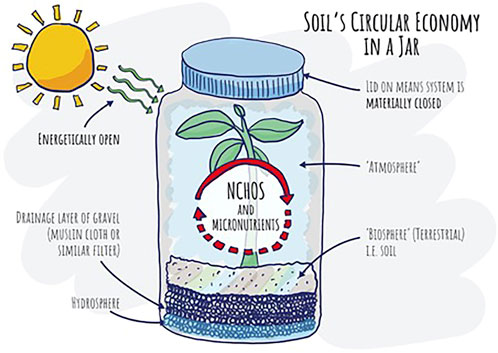
FIGURE 6. Soil in a jar or a terrarium. Building a terrarium using real soil will allow children to understand the links between soil health, plant health, human health and planetary health. Taken from Johnson et al (2022).
The Tamagotchi effect and the ethics of care framework
We know from this survey that Generation Z in these countries, who are the future stewards of the planet Earth, are disconnected and unaware of the natural system of soil. But the survey also reveals (see Figure 3) that the majority of students do know that they should take care of soil. In terms of education, searching for a framework to tap into multi-stakeholder engagement, the analogy of care for a living organism is useful on many levels. Embracing the soil microbiota as a living ecosystem that requires care, not only provides a structural network in which to fit the chemistry, physics, atmospheric interactions, microbiology, governance and education, but also taps into the essence of what stirs and motivates governance and education: an “ethics of care”. The more common framework for education is an “ethics of justice/management” where the emphasis is on dispassionate and detached calculations conducted under specific moral rules, principles and laws (Gilligan 1982). An “ethics of care” taps into desire and relational motivations.
We suggest that building on the fact that children know they should care for the soil we could utilise the ‘Tamagotchi effect’ to facilitate learning. The Tamagotchi effect was a phenomenon in the early 1990s and 2000s, when virtual pets were popular with children (Lawton, 2017). These simulated interactions, that placed an onus of care on children, have been shown to increase engagement and empathy (Tsai and Kaufman, 2009). Analogous virtual care models (ie., of polar bears) are similarly promoted, and have been shown to stimulate environmentally responsible behaviour (Dillahunt et al., 2008). However, authors have argued that the disposable nature of such artificial substitutes can confuse children (Bloch and Lemish, 1999).
We thus propose that terrariums might be the most optimal intervention to target the two primary competency gaps identified in this survey (conceptualisation that soil is living, and the effect of soil degradation on climate change). Particularly, the ideal system would involve building terrariums using living soil (see Johnson, 2022). These can be built by the student and revisited throughout their education to learn about human health, soil health and planetary health.
This type of physical intervention represents a bridge between the four quadrants of insight described in Legitimation Code Theory (LCT). LCT is a framework which is increasingly employed to quantify and measure educational interventions and it facilitates tools to investigate, analyse and interpret knowledge practices in education, specifically those connecting theory and practice (Mouton and Archer, 2019; Pott and Wolf, 2019; Blackie et al., 2022) which is what is needed to connect soil science theory to land management and soil health practices.
Figure 7 shows the four-quadrant representation between “ontic relations” (that identity a phenomenon) and “discursive relations” (ways of approaching the phenomenon). As described by Pott and Wolff (2019), within this quadrant ‘purist insight’ is applicable when there is a clearly theoretical concept, like for example the measurement of a single particle size within a soil (strong ontic and discursive elements). “Doctrinal insight” is appropriate when there are strongly defined procedures, like the scientific method of measuring particle size like using sieves (low ontic, strong discursive elements). “Situational insight’ is most appropriate when there are strong scientific concepts, but more possibilities and less quantifiable open-ended approaches (strong ontic, low discursive). An example of this might even be measuring of soil organic carbon in soil, this is possible and so at first sight might seem like purist insight is possible but in reality different methods produce different results and how these measurements relate to the nature of soil organic matter within soil are up for debate (eg., Lehman and Kleber 2015). For this reason most biological concepts (like the living nature of soil) are appropriately placed in the situational quadrant. Finally, “No/Knower insight’ describes responses that are not based on knowledge (for example intuition, social relations). This “No/Knower insight” could include the relational response to caring for a living organism (the Tamagotchi effect). It is emphasised by Pott and Wolff (2019) that all quadrants represent legitimate forms of insight, and that the most successful students are capable of “code”-shifting well between quadrants.
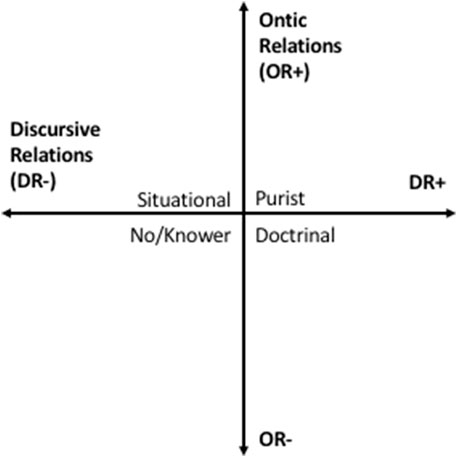
FIGURE 7. The four quadrants described in Legitimation Code Theory which describe the relative importance between ontic relations (whereby a phenonenum can be identified) and discursive relations (different ways of approaching that phenonenum).
This type of educational theory is mostly employed at tertiary level, but the fundamental concepts remain the same at primary and secondary levels. We propose that the knowledge gaps introduced in the “ABC of Soil” survey are due to a historically biased purist and doctrinal approach to soil education, and that terrariums and similar strategically designed tools can stimulate students to switch into the “situational” (biological) and “knower” (relational) quadrants. Pott and Wolff (2019) propose that intentionally facilitating this “code”-switching produces students with greater flexibility and capacity to deal with the complexity of 21st century problems, which is often lacking in scientific realism: the historical educational approaches relying mostly on purist and doctrinal insight.
The future of human health is dependent on soil literacy
Human health is going to depend on stimulating a desire in the next-generation, across nations, to farm the land productively and sustainably, promoting resilient ecosystems and working with nature to produce nutritious food. The “ABC of Soil” survey shows that soil literacy is correlated with seeking out employment in agricultural professions.
Earnings play an important element in most employment decisions. Figure 8 shows that the proportion of individuals that strongly agree or agree with the statement “Farming is a good way to make money” have higher levels of overall soil literacy.
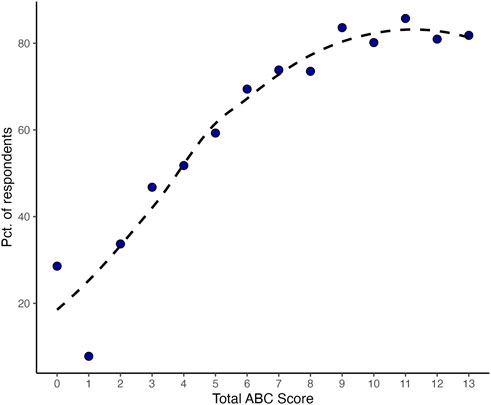
FIGURE 8. Farming is an occupation with good financial returns question (yes or no) from the ABC of soil survey. Taken from Johnson et al (2020).
It is clear that soil health and regenerative agriculture (which means growing food in harmony with the natural environment, using fewer chemicals) is a growth business area in the US and Europe (https://www.forbes.com/sites/forbesbusinesscouncil/2021/08/19/regenerative-agriculture-the-next-trend-in-food-retailing/?sh=5339e3392153). The results shown in Figure 8 hold promise for policymakers hoping to increase employment rates in the agricultural profession across the world; implementing efforts to increase soil literacy may lead to more favourable views towards the economic incentives of working with soil and agriculture, thereby leading to more individuals engaging in such professions and better human health for all.
Data availability statement
The original contributions presented in the study are included in the article/Supplementary Material, further inquiries can be directed to the corresponding authors.
Ethics statement
The studies involving human participants were reviewed and approved by University of Durham. Written informed consent from the participants’; legal guardian/next of kin was not required to participate in this study in accordance with the national legislation and the institutional requirements.
Author contributions
The original concept was formulated by Johnson and the paper written by Johnson as a first draft with all authors contributing equally to the final version of the paper.
Funding
The team would like to acknowledge the United Kingdom’s EPSRC research council for support with their CACTUS (Climate Adaptation Control Technologies for Urban Spaces) grant (EP/R005834/1) which enabled this work to take place. WS was funded by Biogeochemistry Research Infrastructure Platform (BIOGRIP), Stellenbosch University Soil and Water Node, hosted by the South African Department of Science and Innovation.
Acknowledgments
The authors would like to acknowledge the other members of the team who wrote the “ABC of soil” report including Christian Engels and Professor Dennis Philip.
Conflict of interest
The authors declare that the research was conducted in the absence of any commercial or financial relationships that could be construed as a potential conflict of interest.
Publisher’s note
All claims expressed in this article are solely those of the authors and do not necessarily represent those of their affiliated organizations, or those of the publisher, the editors and the reviewers. Any product that may be evaluated in this article, or claim that may be made by its manufacturer, is not guaranteed or endorsed by the publisher.
Supplementary material
The Supplementary Material for this article can be found online at: https://www.frontiersin.org/articles/10.3389/fenvs.2022.1028839/full#supplementary-material
References
Baveye, P. C., Baveye, J., and Gowdy, J. (2016). Soil “ecosystem’ services and natural capital: Critical appraisal of research on uncertain ground. Front. Env. Sci.Sec. Soil Pro. doi:10.3389/fenvs.2016.00041
Bloch, L. R., and Lemish, D. (1999). Disposable love: The rise and fall of a virtual pet. New Media & Soc. 1 (3), 283–303. doi:10.1177/14614449922225591
Blum, W. E. H., Zechmeister-Boltenstern, S., and Keilblinger, K. M. (2019). Does soil contribute to the human gut microbiome? Microorganisms 7 (9), 287. doi:10.3390/microorganisms7090287
Brevik, E. C., Krzic, M., Muggler, C., Field, D., Hannam, J., and Uchida, Y. (2022). Soil science education: A multinational look at current perspectives. Nat. Sci. Eudation 51 (1). doi:10.1002/nse2.20077
Brevik, E. C., Slaughter, L., Singh, B. R., Steffan, J. J., Collier, D., Barnhart, P., et al. (2020). Soil and human health: Current status and future needs. Air, Soil Water Res. January 13, 117862212093444. doi:10.1177/1178622120934441
Ceruti, P., Fey, M., and Pooley, J. U. (2003). Soil nutrient deficiencies in an area of endemic osteoarthritis (mseleni joint disease) and dwarfism in maputoland, South Africa. Geology and health: Closing the gap, 151. doi:10.1093/oso/9780195162042.003.0032
Chianu, J. N., and Mairura, F. (2012). Mineral fertilizers in the farming systems of sub-Saharan Africa. A review. Agron. Sustain. Dev. 32, 545–566. doi:10.1007/s13593-011-0050-0
Clarke, C. E., Stone, W., Hardie, A. S., Quinton, J. N., Blake, L., and Johnson, K. L. (2019). Better together: Water treatment residual and poor-quality compost improves sandy soil fertility. J. Environ. Qual. doi:10.2134/jeq2019.03.0147
Clayton, S., and Karazsia, B. (2020). Development and validation of a measure of climate change anxiety. J. Environ. Psychol. 69, 101434. doi:10.1016/j.jenvp.2020.101434
Cycon, M., Mrozik, A., and Piotrowska-Seget, Z. (2019). Antibitotics in the soil environment – degradation and their impact on microbial activity and diversity. doi:10.3389/fmicb.2019.00338
de Bruyn, L. A. L., and Abbey, J. A. (2003). Characterisation of farmers' soil sense and the implications for on-farm monitoring of soil health. Aust. J. Exp. Agric. 43 (3), 285–305. doi:10.1071/EA00176
de Oliveira Neves, V. G., de Oliveira, D. T., Oliveira, D. C., Oliveira Perucci, L., Dos Santos, T. A. P., da Costa Fernandes, I., et al. (2020). High sugar diet intake, physical activity, and gut microbiota crosstalk: Implications for obesity in rats. Food Sci. Nutr. 8 (10), 5683–5695. doi:10.1002/fsn3.1842
Department for Education (2022). Sustainability and climate change: A strategy for the education and children’s services systems. Available at: https://www.gov.uk/government/publications/sustainability-and-climate-change-strategy/sustainability-and-climate-change-a-strategy-for-the-education-and-childrens-services-systems (accessed Sept 2022).
Dillahunt, T., Becker, G., Mankoff, J., and Kraut, R. (2008). Motivating environmentally sustainable behavior changes with a virtual polar bear. Pervasive 2008 Workshop Proc. 8, 58–62.
Forbes Business Council (2022). Regenerative agriculture the next trend in food retailing. Available at: https://www.forbes.com/sites/forbesbusinesscouncil/2021/08/19/regenerative-agriculture-the-next-trend-in-food-retailing/?sh=5339e3392153 (accessed Sept, 2022).
Francino, M. P. (2016). Antibiotics and the human gut microbiome: Dysbioses and accumulation of resistances. Front. Microbiol. 1543, 1543. doi:10.3389/fmicb.2015.01543
Gwandu, T., Blake, L. I., Nezomba, H., Rurinda, J., Chivasa, S., Mtambanengwe, F., et al. (2021). Waste to resource: Use of water treatment residual for increased maize productivity and micronutrient content. Environ. Geochem Health 44, 3359–3376. doi:10.1007/s10653-021-01100-z
Gwandu, T., Mtambanengwe, F., Mapfumo, P., Mashavave, T. C., Chikowo, R., and Nezomba, H. (2014). Factors influencing access to integrated soil fertility management information and knowledge and its uptake among smallholder farmers in Zimbabwe. J. Agric. Educ. Ext. 20 (1), 79–93. doi:10.1080/1389224X.2012.757245
Johnson, K. L. (2022). A nation that rebuilds its soils rebuilds itself-an engineer's perspective. Soil Secur. 7. doi:10.1016/j.soisec.2022.100060
Johnson, K. L., Philip, D., and Engels, C. (2020). The ABC of soil literacy: Evidence from Ghana, South Africa and Zimbabwe. Project Report. Durham: Durham University. Available at: https://dro.dur.ac.uk/31775/.
Keesstra, S. D., Bouma, J., Wallinga, J., Tittonell, P., Smith, P., Cerda, A., et al. (2016). The significance of soils and soil science towards realization of the United Nations Sustainable Development Goals. SOIL 2 (2), 111–128. doi:10.5194/soil-2-111-2016
Lal, R. (2016). Soil health and carbon management. Food energy Secur. 5 (4), 212–222. doi:10.1002/fes3.96
Lawton, L. (2017). Taken by the Tamagotchi: How a toy changed the perspective on mobile technology. iJournal Student J. Fac. Inf. 2 (2). Available at: https://theijournal.ca/index.php/ijournal/article/view/28127.
Lehmann, J., and Kleber, M. (2015). The contentious nature of soil organic matter. Nature 528, 60–68. doi:10.1038/nature16069
Liang, Z., Fang, W., Luo, Y., Lu, Q., Juneau, P., He, Z., et al. (2021). Mechanistic insights into organic carbon-driven water blackening and odorization of urban rivers. J. Hazard. Mater. 405, 124663. doi:10.1016/j.jhazmat.2020.124663j.jhazmat.2020.124663
M. A. Blackie, H. Adendorff, and M. Mouton (Editors) (2022). Enhancing science education: Exploring knowledge practices with legitimation code theory (Taylor & Francis).
Mouton, M., and Archer, E. (2019). Legitimation code theory to facilitate transition from high school to first-year biology. J. Biol. Educ. 53 (1), 2–20. doi:10.1080/00219266.2017.1420681
O'Keefe, S. J. D. (2019). Plant-based foods and the microbiome in the preservation of health and prevention of disease. Am. J. Clin. Nutr. 110, 265–266. doi:10.1093/ajcn/nqz127
Ochieno, D. M. W. (2022). Soil sterilization eliminates beneficial microbes that provide natural pest suppression ecosystem services against radopholus similis and Fusarium oxysporum V5w2 in the endosphere and rhizosphere of tissue culture banana plants. Front. Sustain. Food Syst. 6. doi:10.3389/fsufs.2022.688194
Ohno, T., and Hettiarachchi, G. M. (2018). Soil chemistry and the one health initiative: Introduction to the special section. J. Environ. Qual. 47 (6), 1305–1309. doi:10.2134/jeq2018.08.0290
Peters, B. A., Yi, S. S., Beasley, J. M., Cobbs, E. N., Choi, H. S., Beggs, D. B., et al. (2020). US nativity and dietary acculturation impact the gut microbiome in a diverse US population. ISME J. 14 (7), 1639–1650. doi:10.1038/s41396-020-0630-6
Platel, K., and Srinivasan, K. (2016). Bioavailability of micronutrients from plant foods: An update. Crit. Rev. Food Sci. Nutr. 56, 1608–1619. doi:10.1080/10408398.2013.781011
Pott, R. W., and Wolff, K. (2019). Using Legitimation Code Theory to conceptualize learning opportunities in fluid mechanics. Fluids 4 (4), 203. doi:10.3390/fluids4040203
Sanchez, P. A. (2002). Soil fertility and hunger in Africa, 295, 55622019–55622020. doi:10.1126/science.1065256
Searle, K., and Gow, K. (2010). Do concerns about climate change lead to distress? Int. J. Clim. Change Strategies Manag. 2 (4), 362–379. doi:10.1108/17568691011089891
Tremaroli, V., and Bäckhed, F. (2012). Functional interactions between the gut microbiota and host metabolism. Nature 489 (7415), 242–249. doi:10.1038/nature11552
Trumbore, S. N. (1997). Potential responses of soil organic carbon to global environmental change PNAS. doi:10.1073/pnas.94.16.8284
Tsai, Y. F. L., and Kaufman, D. M. (2009). The socioemotional effects of a computer-simulated animal on children's empathy and humane attitudes. J. Educ. Comput. Res. 41 (1), 103–122. doi:10.2190/EC.41.1.e
Verlie, B., Clark, E., Jarrett, T., and Supriyono, E. (2021). Educators’ experiences and strategies for responding to ecological distress. Aust. J. Environ. Educ. 37 (2), 132–146. doi:10.1017/aee.2020.34
Keywords: micronutrient malnutrition, terrariums, soil health, human health, soil literacy, sdg
Citation: Johnson KL, Stone W, Dominelli L, Chivasa S, Clarke CE, Gwandu T and Appleby J (2023) Boosting soil literacy in schools can help improve understanding of soil/human health linkages in Generation Z. Front. Environ. Sci. 10:1028839. doi: 10.3389/fenvs.2022.1028839
Received: 26 August 2022; Accepted: 23 December 2022;
Published: 01 February 2023.
Edited by:
Ganga M. Hettiarachchi, Kansas State University, United StatesReviewed by:
Edwin Akley, CSIR-Savanna Agricultural Research Institute, GhanaMatt Limmer, University of Delaware, United States
Copyright © 2023 Johnson, Stone, Dominelli, Chivasa, Clarke, Gwandu and Appleby. This is an open-access article distributed under the terms of the Creative Commons Attribution License (CC BY). The use, distribution or reproduction in other forums is permitted, provided the original author(s) and the copyright owner(s) are credited and that the original publication in this journal is cited, in accordance with accepted academic practice. No use, distribution or reproduction is permitted which does not comply with these terms.
*Correspondence: Karen L. Johnson, a2FyZW4uam9obnNvbkBkdXJoYW0uYWMudWs=
 Karen L. Johnson
Karen L. Johnson Wendy Stone2
Wendy Stone2 Lena Dominelli
Lena Dominelli Stephen Chivasa
Stephen Chivasa Tariro Gwandu
Tariro Gwandu